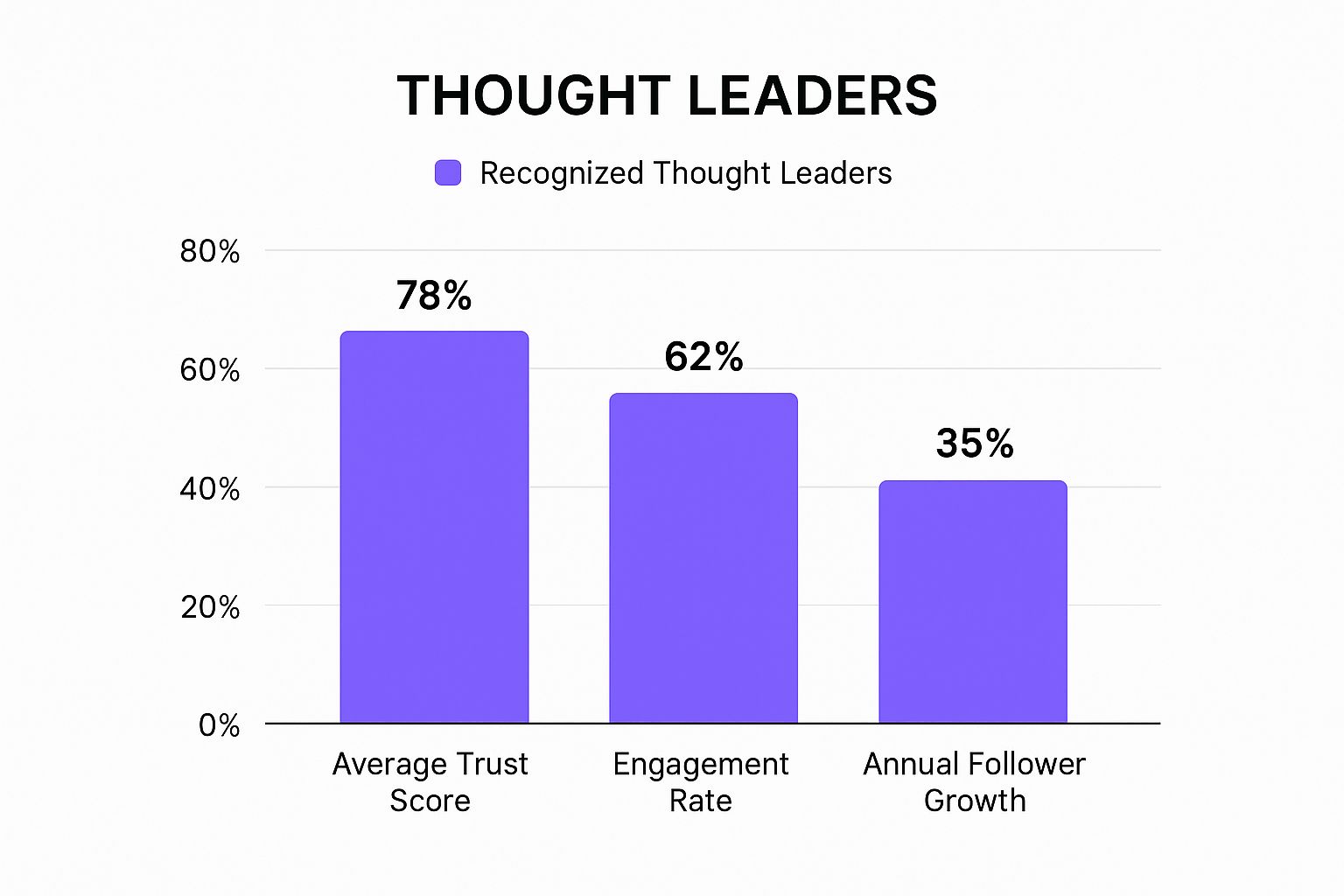Become a Thought Leader in Your Niche

To really become a thought leader, you have to do more than just share generic advice. It's about consistently offering expert insights that solve real problems for a very specific group of people. This means creating original, genuinely valuable content that cements your reputation as the go-to authority in your niche. It’s not just a branding exercise; it’s a strategic commitment to building trust and influence over time.
Why Thought Leadership Is Your Greatest Business Asset
Let's get one thing straight: becoming a thought leader isn't about chasing vanity metrics or online fame. It's a powerful business driver that builds tangible, lasting value. When you establish yourself as a true authority, you’re not just sharing ideas—you are fundamentally changing how potential clients and partners perceive risk and make decisions.
In high-stakes environments, decision-makers are looking for a guide, not just another vendor. They need someone who doesn't just understand the current landscape but has a clear, defensible point of view on where it's all headed. This is precisely where your expertise shifts from being a skill to being a strategic asset.
Building Trust Before the Sale
Real influence has a direct impact on your bottom line. Think about it: when a potential client has been following your work, reading your analysis, and benefiting from your insights for months, the sales conversation starts from a completely different place. It starts from a place of established trust. You’ve already proven your value long before the first official meeting.
This pre-built credibility is priceless. It helps prospects feel far more secure in their choices, especially during complex sales cycles that involve multiple stakeholders. Instead of having to prove your expertise from scratch, you walk into the room with a reputation that precedes you.
Aligning Stakeholders and Reducing Risk
One of the biggest hurdles in B2B sales is getting everyone on the buying committee to agree. A recognized thought leader can be that unifying voice, providing the clarity and confidence needed to get internal teams on the same page. Your public content acts as a third-party validator for the champion who is trying to push for your services inside their own company.
The real power of thought leadership is its ability to de-risk a major decision for a buyer. By consistently providing sharp, actionable insights, you're not just selling a service; you're offering certainty in an uncertain world.
This isn't just a gut feeling. The numbers back it up. A staggering 99% of buyers report that thought leadership is important or critical when they make purchasing decisions. The data below shows how this consistent effort translates into the key metrics that define truly influential voices.

As the infographic makes clear, high trust scores are directly correlated with strong engagement and steady audience growth, creating a powerful cycle of influence.
High-quality thought leadership provides immense strategic value to buyers during their purchasing journey. It helps them navigate complex challenges and make decisions with greater confidence.
How Thought Leadership Influences Buyer Decisions
| Buyer Challenge | How Thought Leadership Helps | Supporting Statistic |
|---|---|---|
| Fear of making a bad investment | Provides expert insights and data that validate a chosen path, making the decision feel safer. | 49% of buyers say it helps mitigate the risk of a poor choice. |
| Getting internal teams to agree | Offers a clear, authoritative perspective that helps align different stakeholders around a common solution. | 49% of buyers confirm it helps align stakeholders on key issues. |
| Cutting through industry noise | Delivers unique, original analysis that separates signal from noise, helping buyers focus on what matters. | 99% of buyers find thought leadership critical or important. |
This data shows a direct link between the expertise you publish and a smoother, more confident buying journey for your clients. Your content doesn't just inform; it facilitates action. You can explore more data on the value of thought leadership in this detailed report.
Defining Your Niche and Core Message
Let's be honest: you can't be a thought leader on everything. And you don't need to be. The real journey begins when you carve out your specific territory—that sweet spot where your passion, expertise, and your audience's biggest headaches all meet. This isn't about limiting yourself; it's about focusing your impact so you can truly own a conversation.
Generic advice just adds to the noise. If you want to stand out, you have to go deep. Your goal is to become the go-to person for a specific problem within a specific community. It's the difference between being a voice and being the voice.
Finding Your Unique Angle
Your unique angle isn’t something you just invent. You uncover it by looking at your own experiences, wins, and even your scars. Start by asking yourself a few direct questions:
- What problems do I solve for people without even thinking? What do friends and colleagues always ask for your advice on?
- What topics do I get lost in for hours, just for fun? Genuine curiosity is a huge clue to a niche you won't get tired of.
- Where have my past failures taught me something invaluable? Those hard-won lessons are often your most powerful assets.
This kind of self-reflection helps you find where you have not just knowledge, but real, practical wisdom. A guide on how to find profitable niches can also offer some great commercial insights, helping you make sure there’s an audience ready and willing to listen.
The most powerful niches are often found at the intersection of two or more disciplines. For example, instead of just "project management," you could specialize in "agile project management for remote creative teams." That specificity immediately makes you more memorable and relevant.
Once you have a few ideas, it's time to see if they have legs. Look for gaps in the market. Are people in online forums asking questions that no one is answering well? Are there common frustrations that the current experts seem to be ignoring? That's where you'll find your opening.
From Broad Topic to Core Message
Once you've zeroed in on your niche, you need to distill all that expertise into a single, compelling core message. This is the central idea that will drive every piece of content you create. It’s your thesis, your unique take on the world that makes you instantly recognizable. A great core message is clear, memorable, and has a distinct point of view.
For example, a general topic might be "social media marketing." A much more powerful core message would be something like, "Authentic community building—not chasing algorithms—is the only way to build a sustainable brand on social media." See the difference? It's opinionated, offers a clear philosophy, and gives you a roadmap for your content.
To shape your own core message, think through this simple framework:
- The Common Misconception: What does everyone in your field seem to believe that you know is wrong or incomplete?
- Your Contrarian Truth: What’s your unique perspective or solution that challenges that common wisdom?
- The Benefit: What positive outcome will your audience get by seeing the world your way?
Platforms like Thinkers360 are living proof of this principle, showcasing how top experts build their reputations around a sharp, specialized focus.

As you can see, influential figures are ranked in very specific categories like "Cybersecurity," "AI," or "Future of Work"—not just "Business." This is the power of niching down in action.
This level of specificity is what turns you from a commentator into a sought-after leader. Your core message becomes your compass, ensuring that every article, post, and talk you give is coherent and reinforces your unique position. Without it, you’re just making content. With it, you’re building a legacy.
Developing Your Signature Content Pillar

Generic blog posts might get you traffic, but they won’t make you a thought leader. To make that leap, you have to stop just commenting on the conversation and start creating it. This is where your signature content pillar comes in—a substantial, original piece of work that becomes your calling card.
Think of it as the definitive resource on a specific topic. It’s the central hub where you plant your flag, offering a genuinely fresh take on your industry's toughest challenges. From this cornerstone, all your other content—social media posts, short articles, and talks—will flow. This is the asset people will reference, share, and remember you for.
This isn't just about writing a long article. It's about generating new knowledge. Your signature content needs to be built on a foundation of original ideas, proprietary data, or a unique framework that only you can bring to the table.
Crafting Your Cornerstone Asset
So, where do you start? First, decide what form your signature content will take. It needs to be beefy enough to showcase deep expertise but accessible enough that your audience will actually dive in.
Here are a few powerful formats I’ve seen work wonders:
- The Groundbreaking Report: Run a survey in your niche and publish the findings. Nothing screams "expert" like original data.
- The Definitive Whitepaper: Go deep. Create a comprehensive, research-backed guide that solves a major industry problem from top to bottom. This becomes a must-read for anyone serious about the topic.
- An In-Depth Video Series: Develop a multi-part video course or documentary-style series. This lets you combine compelling visuals with your expert narration to explore your core message in detail.
- A Unique Framework or Model: Design a proprietary process that simplifies a complex concept. Think of big-idea frameworks like HubSpot's Inbound Methodology or Simon Sinek's Golden Circle.
The goal is to create something with a long shelf life. You’re aiming for an asset people will be downloading and citing for years, not just weeks. This is your legacy piece.
Leveraging AI for Deeper Insights
In a world drowning in information, your ability to unearth fresh insights is what will set you apart. This is where artificial intelligence becomes your secret weapon. The sharpest minds are already using AI in their research and analysis workflows to get an edge.
In fact, the 2025 B2B Thought Leadership Outlook Report from Thinkers360 found that around 67% of thought leaders plan to use AI to bolster their research. This isn't about being lazy; it's about cutting through the noise to find unique angles others miss. You can discover more about how AI is shaping the future of thought leadership in their full report.
Your signature content isn't just a summary of existing knowledge; it’s a contribution of new knowledge. Use AI not as a writer, but as a super-powered research assistant to analyze data, identify patterns, and connect dots that aren't immediately obvious.
For instance, you could use an AI tool to sift through hundreds of customer reviews to pinpoint unspoken pain points. Or you could have it analyze a decade’s worth of industry reports to spot a long-term trend no one is talking about. This lets you build your pillar on a foundation of data-driven originality, not just opinion.
From Big Idea to Finished Product
Developing a signature content pillar is a real project, and you need to manage it like one. A brilliant idea can be completely undermined by sloppy execution.
Once you have your core concept and have done your initial research, it's time to map out the production process. Here’s a simple roadmap to keep you on track:
- Create a Detailed Outline: Break your pillar down into sections, chapters, or episodes. Define the key argument for each part and make sure it supports your overall thesis.
- Gather Your Raw Materials: This is where you collect all the data, interviews, case studies, and personal stories. This is the evidence that will back up your claims and make your content rock-solid.
- Draft the Content: Just get the ideas down. Don't stress about perfection on the first go. Focus on clarity, logic, and telling a compelling story.
- Refine and Polish: Now it’s editing time. Check for flow, strengthen your arguments, and polish your language until it shines. It's always a good idea to get feedback from a trusted peer who really understands your audience.
- Design and Package: Presentation matters. A lot. Invest in professional design to make your report, whitepaper, or video series look as authoritative as it sounds.
Following this process ensures your final asset isn't just insightful but also polished and professional—a true reflection of your expertise and a powerful tool for solidifying your status as a thought leader.
Amplifying Your Voice and Building a Community

Creating a brilliant piece of signature content is a massive achievement, but it’s only half the battle. Let's be honest: the most insightful report in the world is useless if no one ever sees it. Now, it's time to shift your mindset from creator to amplifier.
Your next mission is to get your hard-earned wisdom in front of the right people and start building a real community around your ideas. This isn’t about just spamming links everywhere. It’s about smart, strategic distribution and showing up where your audience already spends their time. This is how you turn passive readers into active fans and truly become a thought leader in their eyes.
Create a Multi-Channel Distribution Plan
Hitting "publish" once and calling it a day is not a distribution strategy. To get the most mileage out of your cornerstone content, you need a plan to show up consistently across the platforms where your target audience hangs out.
Think of your signature content as the sun; all your smaller content pieces are planets orbiting it. The key is to smartly repurpose that main asset into dozens of different formats.
- For the LinkedIn Crowd: Pull key data points from your report and turn them into sharp infographics or carousels. Grab a powerful quote, create a simple text-based post, and ask your network if they agree or disagree.
- For the Visual Learners: Chop up your main content into short video clips—think 30-90 seconds—explaining a single concept. These are perfect for platforms like X, Instagram Reels, or YouTube Shorts.
- For the Niche Forum Dwellers: Find relevant discussions on Reddit or in specialized industry forums. But don't just drop a link and run. Write a thoughtful comment summarizing a key finding from your content that directly answers a user's question, then link to your full piece for more detail.
This approach ensures you’re not just repeating yourself. You’re tailoring the message to fit the unique culture of each platform, which will dramatically increase your engagement.
The Art of Authentic Engagement
Amplification is more than just broadcasting; it's about building relationships. Thought leadership is a two-way street. You build real authority not just by speaking, but by listening and participating in the broader conversation with generosity.
True influence is built in the replies, not just in the posts. It’s about showing up, offering help without expecting anything in return, and proving you're a valuable member of the community first and an expert second.
Engage with other experts in your field. When they post something insightful, jump into the comments with your own perspective. Answer questions from your followers with thoughtful, detailed responses. The goal is to become known as someone who consistently adds value wherever they show up.
To really get this right, it helps to dig into proven strategies for building a thriving online community. This knowledge is what separates a passive audience from an active, engaged group of advocates.
Turn Followers Into Advocates
The ultimate goal here is to create a loyal following that not only consumes your content but actively champions it. When your audience starts sharing your work and tagging you in relevant conversations without you asking, you've hit a new level of influence.
Here’s how you can encourage that shift:
- Be Incredibly Responsive: When someone shares your work or asks a great question, acknowledge them publicly. A simple "Thanks for sharing!" or a detailed reply can make a huge impact on how they perceive you.
- Create Exclusive Opportunities: Offer your most engaged followers something extra. This could be a private Q&A session, early access to new content, or an invitation to a small group discussion. It rewards their loyalty and makes them feel like valued insiders.
- Actively Listen and Adapt: Pay close attention to the questions your community asks. These are gold. They are direct signposts telling you what content you should create next. When you create something based on their feedback, you show them their voice matters.
This cycle of creating, sharing, listening, and responding is the engine that drives sustainable thought leadership. It transforms your personal brand from a monologue into a dynamic, community-powered dialogue.
Turning Influence Into Tangible Business Results
Let's be honest. Influence without impact is just a vanity project. True thought leadership pays real dividends, turning your hard-won authority into business results you can actually measure. The goal isn't just to be known; it's to build a sustainable, profitable engine fueled by your expertise.
This is where you connect the dots between your growing reputation and your bottom line.
A lot of aspiring experts get stuck right here. They build an audience but have no idea how to turn that attention into anything tangible. The secret is to stop thinking like a content creator and start thinking like a business owner. Your expertise is the product. Your influence is the marketing.
Tracking the Metrics That Matter
To prove this whole thing is working, you need to track the right numbers. Forget chasing likes and follower counts for a moment. Those are indicators, not outcomes. The real ROI shows up in your business operations.
Keep an eye on these KPIs:
- Lead Quality: Are the leads from your content more informed? They should already get your philosophy and be practically pre-sold on your approach before they even talk to you.
- Sales Cycle Length: High-quality leads built on trust often fly through the sales process. Track the time from first contact to a signed contract for followers versus non-followers. You'll likely see a big difference.
- Inbound Opportunities: Are you getting unsolicited emails for speaking gigs, podcast interviews, or advisory roles? This is a direct signal of your growing authority.
- Deal Size: Clients who hunt you down for your specific expertise are usually willing to pay a premium. This means bigger, more profitable projects.
High-growth companies are already all over this. Top SaaS startups, for instance, are dedicating budgets of up to $140,000 annually just for thought leadership SEO. They aren't throwing that cash around for fun; they're investing in a proven driver of high-quality leads and market authority.
Building a Business Model Around Your Expertise
Once you start seeing these positive signals, it's time to formalize how people can pay you. Your business model should give your audience clear pathways to work with you, whether they have a small budget or a large one.
For many who become a thought leader, the end game is to monetize their knowledge directly. This can look a few different ways, each designed for a different kind of customer.
Your content attracts the audience, but your business model is what captures the value. Don't leave it to chance. Deliberately design how people can pay you for your expertise.
Here are some of the most effective ways to do it:
- High-Ticket Consulting or Client Services: This is the most direct route. Use your content to attract your ideal clients—the ones who need your specific expertise to solve a huge business problem.
- Paid Communities or Masterminds: Create an exclusive space for your most dedicated followers. They get deeper access to you and can connect with other sharp, like-minded people.
- Advisory Roles and Board Seats: As your reputation grows, companies will want your strategic brainpower. This often comes in the form of lucrative retainers for just a small fraction of your time.
- Digital Products and Courses: Package your signature framework or process into a scalable product. This lets you serve a much wider audience than you ever could one-on-one.
For many thought leaders, the ultimate tangible result is creating their own successful business. Learning from models like building a profitable one-person agency can offer a clear roadmap for spinning personal expertise into a thriving company. This is the very definition of converting influence into independence and financial success, proving that a strong personal brand is one of the most valuable assets you can ever build.
Got Questions About Thought Leadership? I've Got Answers.
When you're starting out, a million questions pop into your head. It's totally normal. Here are some of the most common ones I hear from aspiring thought leaders, along with some straight-up, real-world advice to help you cut through the noise.
"Okay, For Real... How Long Is This Going to Take?"
Everyone wants a magic number, but there isn't one. The honest answer? Plan for a marathon, not a sprint. You should be looking at 18-24 months of consistent, dedicated work before you really start to see the needle move in a big way.
The first year is all about laying the groundwork. This is where you'll be heads-down, defining your niche, building out your signature content, and getting your systems dialed in. Year two is when things get exciting—that's when you can really hit the gas on growing your audience and start turning that influence into real opportunities, like paid speaking gigs or consulting work.
The most critical factor is consistency. Showing up with valuable insights day after day, week after week, is what separates fleeting experts from true, lasting thought leaders. It's a long-term commitment to serving an audience.
"What’s the Single Biggest Mistake I Can Make?"
Easy. Focusing on yourself instead of your audience. The biggest pitfall is treating thought leadership as a platform for self-promotion. It's not about shouting your resume from the rooftops or constantly pitching your services.
True thought leadership is an act of service. Spend 90% of your time genuinely trying to solve problems for people in your niche. When you generously share what you know—educating, informing, and helping—the authority, trust, and business opportunities will follow. It's a path paved with generosity, not ego.
"How Do I Figure Out My Unique Angle?"
Your unique angle isn't just about what you know; it's about where your specific knowledge meets an underserved audience need. The key is to stop thinking broad and start getting incredibly specific.
- Go Deeper, Not Wider: Instead of just "marketing," narrow it down to "customer lifecycle marketing for early-stage SaaS companies." See the difference?
- Connect Unrelated Fields: What happens when you mix two different disciplines? You get something new, like applying "game design principles to corporate employee onboarding."
- Take a Contrarian (But Smart) Stance: Find a commonly held belief in your industry and challenge it with a well-reasoned, alternative viewpoint.
Your most powerful voice emerges when you find a specific problem that others are either ignoring or getting wrong, and you're the one with the answer.
Ready to build a powerful personal brand that attracts opportunities? MakerBox helps you create an optimized professional presence across social media in seconds. Generate engaging bios, posts, and striking profile photos to solidify your status as a go-to expert. See how it works at https://www.makerbox.io.





